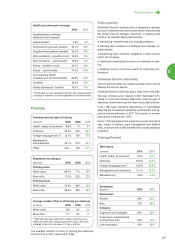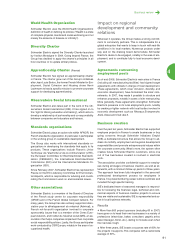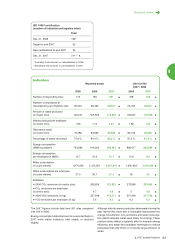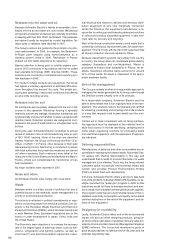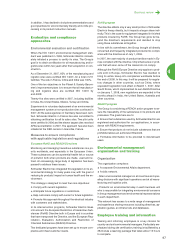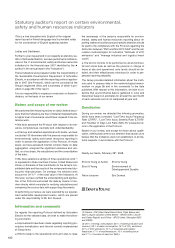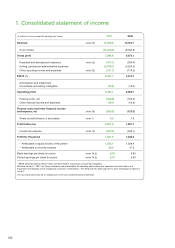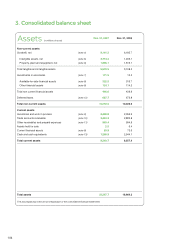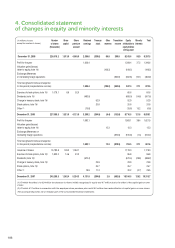APC 2007 Annual Report Download - page 99
Download and view the complete annual report
Please find page 99 of the 2007 APC annual report below. You can navigate through the pages in the report by either clicking on the pages listed below, or by using the keyword search tool below to find specific information within the annual report.
97
4
Business review
In addition, it has decided to include recommendations and
good practices for environmentally friendly end-of-life pro-
cessing in its product instruction manuals.
Evaluation and compliance
approaches
Environmental evaluation and certification
When the ISO 14001 environmental management stan-
dard was published in 1996, Schneider Electric immedi-
ately initiated a process to certify its sites. The Group’s
goal is to obtain certification for all manufacturing and lo-
gistics sites within two years after their acquisition or con-
struction.
As of December 31, 2007, 85% of the manufacturing and
logistics sites were certified ISO 14001, for a total of 211
facilities. The rate in France, China and India was 100%.
One of the ten objectives in the Planet & Society Barom-
eter’s improvement plans is to ensure that all manufactur-
ing and logistics sites are certified ISO 14001 by
end-2008.
Twenty-five sites were certified in 2007, including facilities
in India, the United States, Mexico, Turkey and China.
Experiments in voluntary deployment of an environmental
management system at non-production sites continued in
2007. All the sales agencies in Germany have been certi-
fied. Schneider Electric in France has also committed to
obtaining certification for all its sales sites. Two pilot units
were certified in 2006 and the eleven largest sites received
AFAQ accreditation in 2007. The approach has also been
initiated at the R&D centers in Grenoble, France.
Measures to ensure compliance
with applicable legislation and regulations
European RoHS and REACH Directives
Monitoring and managing hazardous substances is a pri-
ority worldwide, and especially in the European Union.
These substances can be a potential health risk or source
of pollution both when products are made, used and re-
tired. An increasingly large body of legislation has been
passed to address these issues.
Schneider Electric has integrated this legislation in its en-
vironmental strategy for many years now, with the goal of
reducing its products’ impact on human health and the en-
vironment.
This strategy is designed to meet four core objectives:
Comply with current legislation.
Anticipate future regulations or restrictions.
Help customers comply with current or future legislation.
Promote this approach throughout the electrical industry
with customers and stakeholders.
In its internal action programs, Schneider Electric takes
into account the European Restriction of Hazardous Sub-
stances (RoHS) Directive both in Europe and in countries
that have transposed the Directive, and the European Reg-
istration, Evaluation, Authorization and Restriction of
Chemical Substances (REACH) Directive.
Two dedicated programs have been set up to ensure com-
pliance and meet customer needs.
RoHS program
The directive affects only a very small portion of Schneider
Electric’s lineup directly, but it impacts a larger share indi-
rectly. This is the case for equipment integrated in finished
products covered by RoHS. The Group has gone far be-
yond the directive's requirements and decided to stop
using these substances all together.
In line with its commitment, the Group brought all directly
concerned and frequently integrated products into compli-
ance with the directive as of July 1, 2006.
In 2007, the vast majority of product families made in Eu-
rope complied with the directive. Only small series or prod-
ucts that will soon come off the market do not comply.
Although the RoHS Europe Directive only applies to prod-
ucts sold in Europe, Schneider Electric has decided to
bring its entire lineup into compliance worldwide before
the end of 2008. In this way, it will be prepared for regula-
tory changes in other countries, such as China, where
equivalent legislation took effect on March 1, 2007. After
South Korea, which implemented its own RoHS Directive
on January 1, 2008, new regulations are expected in the
months ahead in India, the United States, Australia and
other countries.
REACH program
The Group is considering a REACH action program to en-
sure the traceability of the substances in its products and
processes. The goals here are to:
Ensure that substances used by Schneider Electric are
registered and authorized for our applications, in accor-
dance with REACH requirements.
Ensure that products do not include substances that are
prohibited above an authorized threshold.
Formalize information to be provided to downstream
users.
Environmental management
organization and training
Organization
The organization comprises:
A corporate Environmental Affairs department.
A skills network.
- Sites: environmental managers in all countries and oper-
ating divisions with significant operations and at all manu-
facturing and logistics units.
- Products: an environmental relay in each business unit
who is responsible for integrating environmental concerns
in lineup management and environmental representatives
in each department.
This network has access to a wide range of management
and experience sharing resources including directives, ap-
plication guides, an intranet site and databases.
Employee training and information
Training and informing employees is a key mission for
country and unit environmental managers. Particularly em-
phasized during site certification, training is facilitated by a
28-module e-learning package that takes about 15 hours
to complete.


